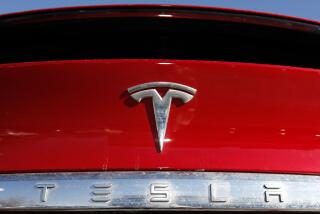Tesla’s high-margin cars are aging out. Can the Model 3 make up the difference?
Tesla Inc. is delivering more cars than ever because of the emergence of Model 3 customers like Mike Land. His view of the relative weakness of Elon Musk’s more expensive electric cars also helps explain why the company is still struggling to make money.
The price tags on Tesla’s first two vehicles, the Models S and X, were too much for Land’s budget to bear. But the retired police officer probably wouldn’t want one of those cars anyway over his Model 3, since the older models no longer feature what he considers to be cutting-edge tech.
“Even if I could afford it — let’s say I won the lottery tomorrow, and I could afford a Model S or a Model X — the battery technology is still older,” the 55-year-old said from his home in a suburb of Tucson.
The Model 3 brought new buyers into the fold and countered the narrative that Tesla is demand challenged, sparking a stock rally since the beginning of June. But the electric-car maker’s shares are still down 22% for the year in part because the Models S and X are beginning to show their age. Slower-charging and less efficient batteries are taking some of the wind out of their sails and pressuring Tesla’s profit margins, since they often sell for more than double the cost of an entry level Model 3.
Combined deliveries of the Models S and X dropped more than 20% from a year ago to 17,650 in the second quarter. The Model 3, meanwhile, saw deliveries jump to 77,550.
Deliveries of the Models S and X were “anemic” and “a bit of a concern given higher margins for these cars,” Craig Irwin, an analyst at Roth Capital Partners, wrote in a report Monday. He downgraded the stock to neutral after recommending it as a buy for just 42 days.
A further compression of margins could spell trouble for Tesla, which is expected to report its second-quarter financial results on Wednesday. The company reported a larger-than-expected loss in the first quarter after repeated assurances it would stay in the black. Last month, Musk said rapid growth in sales may actually make it harder for Tesla to be sustainably profitable.
In the first quarter, Tesla’s automotive gross margins excluding certain items compressed to 20.3% from 24.7% in the last three months of 2018. The company has said it’s targeting 25% margins for the Models S, X and 3.
The sticker-price gap between the Model 3 and Tesla’s other models grew wider on July 16 when Tesla dropped the starting price of the Model 3 in the U.S. and simultaneously eliminated a less expensive standard-range version of the Model S sedan from the lineup. The Model 3 now starts at $38,990, and the cheapest version of the Model S is $79,990.
Despite the higher prices, the Models S and X are very long in the tooth by auto industry standards. Vehicles are typically completely overhauled every four or five years to remain competitive, but the Model S debuted in June 2012 and the Model X hit the market in 2015. Since then, neither has undergone a major revamp in battery technology, interior upgrades or sheet-metal styling.
“They seem to be holding up OK without a redesign, but it’s unusual for a car company, especially a luxury maker, not to do a redesign,” said Michelle Krebs, senior analyst at Autotrader. “Usually, they’re about every four years and maybe a re-freshening in between.”
Tesla has provided over-the-air software upgrades to boost performance and add features for existing Model S and Model X owners, but Musk dashed hopes for more significant changes to the vehicles on July 9, when he tweeted that there is “no ‘refreshed’ Model X or Model S coming.”
A lack of any major redesigns is one reason for the diminishing sales of the S and X, said Jeremy Acevedo, an analyst at Edmunds. “You’re not going to bring existing shoppers out of the woodwork,” he said. “That’s a problem that most automakers face once these vehicles hit the end of their life cycle. It’s just harder to sell” them.
If Tesla sells enough of its Model 3, then sheer volume may make up for a lower profit margin per vehicle. And as word of mouth spreads about Tesla’s latest car, the company could win over buyers who might otherwise never have considered the brand.
Brad Silverberg, a retired software company and venture capital executive, said a friend recommended he take a Model 3 for a test drive near his home on the outskirts of Seattle. “He raved about how much he loved driving the car,” Silverberg said of his friend. “I decided not to over-think it, got a test drive, and bought one.”
“I wouldn’t have done this with a Model S or X,” he said.
While Tesla’s older models may no longer be reliable cash cows, Edmunds analyst Acevedo expects Model S and X sales to stabilize at some point.
“I don’t think they’ll fall off a cliff,” he said. “They did have some price cuts, so Tesla is aware of their diminishing sales and will probably see this as another method to stimulate” demand.
More to Read
Inside the business of entertainment
The Wide Shot brings you news, analysis and insights on everything from streaming wars to production — and what it all means for the future.
You may occasionally receive promotional content from the Los Angeles Times.










